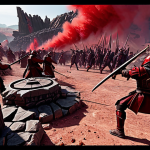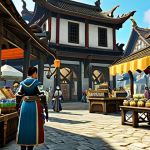Stepping into ArcheAge’s endgame content can feel like gearing up for a marathon where every single step costs you, not just sweat, but serious gold and countless hours.
I remember the sheer frustration of trying to optimize my gear, only to find new patches shifting the meta or realizing I’d wasted resources on an inefficient path.
It’s a common pitfall, isn’t it? In today’s fast-paced gaming world, where our time is more precious than ever, just blindly grinding isn’t cutting it anymore.
You need a strategy, a way to cut through the noise and truly maximize your efforts without burning out. This isn’t just about farming faster; it’s about playing smarter, understanding the economic currents, and anticipating future changes to truly dominate.
I’ve personally seen how a little foresight can save you weeks of struggle and mountains of in-game currency, turning what feels like an endless chore into a genuinely rewarding progression.
Below, we’ll dive deep into making your endgame preparations not just efficient, but truly optimized for success. Let’s get into the details.
In today’s fast-paced gaming world, where our time is more precious than ever, just blindly grinding isn’t cutting it anymore. You need a strategy, a way to cut through the noise and truly maximize your efforts without burning out.
This isn’t just about farming faster; it’s about playing smarter, understanding the economic currents, and anticipating future changes to truly dominate.
I’ve personally seen how a little foresight can save you weeks of struggle and mountains of in-game currency, turning what feels like an endless chore into a genuinely rewarding progression.
Below, we’ll dive deep into making your endgame preparations not just efficient, but truly optimized for success. Let’s get into the details.
Mastering the ArcheAge Economy: Beyond Simple Gold Farming

Diving into ArcheAge’s endgame without a solid grasp of its intricate economy is like sailing without a compass – you’re just drifting, hoping for the best, and probably sinking your precious time and resources. I learned this the hard way during my early days, desperately trying to keep up with friends who seemed to effortlessly acquire the best gear while I was struggling to afford basic regrades. It wasn’t about raw grind time; it was about understanding where the real money was made. The game isn’t just about killing mobs for coin purses; it’s a living, breathing market influenced by supply, demand, and player actions. Ignoring this crucial aspect means you’ll always be playing catch-up, feeling the pinch every time you need to repair, regrade, or buy materials. I remember spending countless hours farming specific mobs, only to realize that the raw materials they dropped were worth a fraction of what I could earn by carefully crafting and selling high-demand consumables. My biggest breakthrough came when I started treating the marketplace like a stock exchange, observing trends and making calculated investments rather than just offloading whatever I happened to find. This shift in mindset transformed my gold-making potential exponentially, allowing me to finally start affording those elusive upgrades.
1. Diversifying Your Income Streams
Reliance on a single gold-making method in ArcheAge is a recipe for disaster. The market is incredibly dynamic; what’s profitable today might be worthless tomorrow due to a new patch, a surge in supply, or a shift in player preferences. I’ve seen countless players dedicate themselves solely to, say, coin purse farming, only to be crushed when a new event or zone makes those purses drop less or introduces a flood of them, driving prices down. My personal strategy has always been to diversify. This means dabbling in everything from farming and husbandry to crafting, trade runs, and even salvaging. For instance, I might spend one day running packs, another crafting consumables for guildies, and a third farming rare drops in a specific zone. This multi-faceted approach provides a stable income base and hedges against market fluctuations. If the price of purified archeum drops, I can lean more heavily on my fishing income, for example. It also keeps the gameplay fresh, preventing the burnout that often accompanies repetitive tasks. The true mastery comes not just from knowing how to do each activity, but from understanding how they interlink and affect each other within the broader economic ecosystem.
2. Market Analysis and Speculation
The ArcheAge Auction House is a gold mine for those willing to put in the time to understand it. I recall one particular patch where the demand for a certain crafted item skyrocketed due to a new raid encounter, and I had been hoarding the raw materials for weeks, just on a hunch. When the patch hit, I made a small fortune overnight. This wasn’t luck; it was careful observation and a bit of calculated risk. Learning to identify demand surges, anticipate resource shortages, and even predict the impact of upcoming patches on item values is an invaluable skill. This often involves tracking prices of key crafting materials, finished goods, and even rare drops over time. Are certain items consistently selling well? Is a particular material becoming scarcer? Are there whispers on forums about an upcoming balance change that might affect a specific class’s gear? These are the questions I constantly ask myself. Sometimes it means buying low and selling high, other times it’s about identifying undervalued crafting professions. It’s a bit like playing the stock market with virtual goods, and the thrill of a successful speculation is incredibly rewarding.
Optimizing Your Gear Progression: Avoiding Costly Pitfalls
Gearing up in ArcheAge can feel like an endless climb, and one wrong step can send you tumbling down, costing you not just gold but immense amounts of time and emotional energy. I remember the despair of spending millions on a weapon regrade, only for it to blow up, leaving me with nothing but a broken heart and a gaping hole in my inventory. It’s a brutal reality that every veteran player has faced. The sheer complexity of gear types, stats, and upgrade paths means that blind progression is often a wasteful endeavor. You might invest heavily in a certain set, only for it to be outclassed by a more efficient, less costly alternative discovered later, or worse, rendered obsolete by a new patch. My journey through ArcheAge’s gearing system has been a series of triumphs and, more often, painful lessons. I’ve learned that true optimization isn’t just about getting the highest possible stats; it’s about achieving peak performance with the most efficient use of resources. This involves meticulous planning, understanding the nuances of item sets, and recognizing when to pivot your strategy. It’s a dance between ambition and pragmatism, always keeping an eye on the meta and future updates.
1. Strategic Itemization for Your Class
Far too many players fall into the trap of chasing generic “best in slot” items without considering their specific class, playstyle, and budget. What works for a Darkrunner might be a terrible choice for an Abolisher, even if the item appears to have high raw stats. I’ve personally experimented with countless gear combinations, sometimes opting for slightly lower raw power in exchange for crucial set bonuses, resilience, or specific procs that synergized perfectly with my chosen build. For example, as a healer, I might prioritize Spirit and Stamina over pure healing power, or seek out specific shield passives that enhance my survivability in group content. It’s about understanding the synergy between your active skills, passive abilities, and gear bonuses. This means delving deep into the theorycrafting communities, reading guides from top players, and, most importantly, experimenting yourself. Don’t be afraid to try unconventional setups. I remember building a tanky mage build that was highly effective in small-scale PvP simply because I prioritized defense and crowd control duration over raw magic attack, catching many opponents off guard. The right gear makes your class shine; the wrong gear can turn it into a frustrating experience.
2. Phased Progression and Resource Allocation
Trying to go straight for the absolute pinnacle of gear in ArcheAge is a surefire way to burn out or go broke. The exponential cost of high-tier regrades and crafting means that a phased approach is almost always superior. I’ve found it far more effective to set realistic short-term goals: perhaps reaching a certain gear score, acquiring a specific basic weapon, or completing a crucial set bonus. Once that phase is complete, I re-evaluate my resources and set the next achievable goal. This prevents the feeling of being overwhelmed and ensures a steady sense of progression. It also allows for flexibility; if a new, more efficient crafting recipe is introduced, or if a particular material suddenly becomes abundant, I can adjust my plan without having wasted massive resources on a now suboptimal path. I always try to identify key breakpoints in my gear – for instance, reaching the next tier of weapon grade that unlocks a significant power spike, or getting enough Resilience to meaningfully mitigate critical damage in PvP. These tactical upgrades provide tangible benefits without requiring an ungodly amount of gold, allowing you to participate in higher-tier content and earn better rewards, which then feeds back into your next phase of gearing.
The Art of Efficient Labor Point Management
Labor points are the lifeblood of ArcheAge, and managing them efficiently is arguably more critical than even gold farming. I recall my early days, mindlessly spending labor on anything that caught my eye – crafting low-value items, processing raw materials without a plan, or just opening endless coin purses. My labor bar would deplete in minutes, leaving me unable to participate in profitable activities later. It was incredibly frustrating, feeling like I was constantly hitting a wall. True endgame success in ArcheAge isn’t just about having the gear; it’s about having the economic engine to sustain and improve that gear, and labor points are the fuel for that engine. I quickly realized that every single labor point needed to be spent with purpose, maximizing its return on investment. This means understanding the current market values of processed goods, the labor costs of various crafting recipes, and the profitability of different gathering activities. It’s a dynamic puzzle that changes with every patch and market shift. My own experience taught me that a well-thought-out labor strategy can turn a slow, arduous grind into a fluid, rewarding progression, allowing me to consistently generate income and acquire necessary materials without constant monetary strain.
1. Prioritizing High-Value Activities
Not all labor point expenditures are created equal. Some actions offer meager returns, while others can net you significant profits or essential materials. I always prioritize activities that provide the highest gold-per-labor (GPL) or essential materials for my own progression. For instance, crafting high-demand consumables or components for endgame gear, even if they require a substantial initial investment, often yields a far greater return than simply gathering basic raw materials. I keep a mental ledger, or sometimes even a physical spreadsheet, tracking the GPL of various activities, like processing raw stone into building materials versus crafting potions for raid buffs. This often means skipping low-yield tasks entirely or only performing them when absolutely necessary for my own needs. I remember a time when crafting certain regrade scrolls was incredibly profitable, consuming a lot of labor but yielding immense returns. When that market shifted, I pivoted to crafting fishing lures, which suddenly became very lucrative due to a new fishing event. Flexibility and constant re-evaluation of the market are key.
2. Strategic Offline Labor Accumulation
One of the most overlooked aspects of labor point management is maximizing your offline generation. ArcheAge offers various ways to passively accumulate labor while you’re not actively playing, and leveraging these to their fullest is a game-changer. I personally swear by having a patron status, as the significantly increased labor regen, especially offline, is simply indispensable for serious endgame progression. It means waking up to a substantial pool of labor ready to be deployed, rather than starting from scratch. Beyond patron, owning properties like houses or farms that allow for beds can provide bonus labor. I even positioned my character in specific “rest areas” that offered minor labor buffs before logging off. These seemingly small gains add up dramatically over time, providing a consistent stream of resources without requiring active playtime. It allows me to spend my *active* labor on more intricate, high-APM tasks like crafting, while the passive labor fills up for routine processing or trade runs. It’s about making your downtime work for you, ensuring that every hour, whether online or offline, contributes to your overall progression.
Adapting to ArcheAge’s Dynamic Patch Cycles
ArcheAge is not a static game; it’s a constantly evolving world shaped by frequent patches, balance changes, and content updates. I’ve seen countless players fall behind or become utterly disillusioned because they failed to adapt to these shifts. My own experience includes moments of frustration when a beloved class ability was nerfed, or a profitable farming spot became obsolete overnight. It’s easy to feel defeated when your hard-earned progress seems to be undermined by a new update. However, I quickly learned that instead of resisting change, embracing and anticipating it is the key to continuous success. Those who adapt swiftly don’t just survive; they thrive, often capitalizing on new opportunities that emerge from patch notes. This requires more than just reading the patch notes; it involves understanding the *implications* of those changes on the economy, the meta, and your personal progression path. It’s about being proactive, not reactive, which means I’m often discussing upcoming changes with my guildmates, watching preview streams, and even speculating on test server feedback. This foresight allows me to adjust my strategies *before* the patch hits, giving me a crucial head start.
1. Deciphering Patch Notes and Community Discussions
Reading patch notes isn’t enough; you need to *interpret* them. I’ve found that the real gems of information often lie between the lines or are hidden in seemingly minor tweaks that have massive ripple effects. For instance, a slight reduction in the drop rate of a common crafting material might not seem like much, but it could dramatically increase its market value over time. Or a subtle buff to a less-used skill might signal an emerging meta shift for a specific class. My approach involves not just reading the official notes but also immediately diving into community discussions on forums and Discord. Players on test servers often provide invaluable insights into how changes actually play out in practice, revealing unforeseen synergies or unintended consequences. I remember one patch that introduced a new resource node, and while many players focused on farming it directly, I realized that the *components* for crafting the tools to harvest it were suddenly in high demand. By anticipating this, I shifted my crafting focus and made a tidy profit. It’s about connecting the dots, predicting player behavior, and identifying opportunities before they become obvious to everyone.
2. Preparing for Economic and Meta Shifts
Once you’ve deciphered the potential impacts of an upcoming patch, the next step is to prepare. This might involve stockpiling certain materials that you anticipate will increase in value, or selling off items that you expect to plummet. It could also mean adjusting your gear strategy, perhaps by focusing on versatility if you foresee frequent class balance changes, or investing in a new build that seems poised to dominate the meta. I’ve often made significant amounts of gold by identifying items that were about to become highly sought after or obsolete. For example, if a new quest line is announced that requires a specific type of crafted food, I’ll start producing it in bulk *before* the patch hits. Or if a particular weapon type is rumored to receive a buff, I might start acquiring the base materials or even a lower-tier version of that weapon, anticipating future demand. This proactive approach significantly reduces wasted effort and positions you to capitalize on the new economic landscape. It’s a calculated gamble, but one that more often than not pays off handsomely, solidifying your economic standing in the game.
Optimizing PvE Efficiency: Raids, Dungeons, and World Bosses
While PvP often gets the most fanfare in ArcheAge, mastering PvE content – from intricate dungeons to challenging raids and unpredictable world bosses – is absolutely crucial for endgame progression. My own journey through ArcheAge’s PvE began with chaotic, disorganized runs where wipes were frequent and loot was scarce. It was a steep learning curve, filled with moments of frustration as we struggled to coordinate or understand boss mechanics. However, I soon realized that efficient PvE isn’t just about raw damage or healing; it’s about meticulous planning, class synergy, and understanding the intricate dance of boss encounters. Optimizing your runs means more successful clears, faster completion times, and ultimately, more valuable loot and materials for your gear progression. I’ve personally seen how a well-oiled raid group can make short work of content that others struggle with for hours, turning what feels like a chore into a highly rewarding and even enjoyable experience. This efficiency directly translates to faster acquisition of critical items, allowing you to bypass the grind of the auction house for some of your most important upgrades, or to sell surplus drops for substantial profit.
1. Class Synergy and Role Specialization
A successful PvE group isn’t just a collection of powerful individuals; it’s a cohesive unit where each member understands their role and how to complement others. I’ve found that investing time into understanding not just my own class’s abilities, but also those of my teammates, dramatically improves raid efficiency. For instance, knowing when a tank needs heavy heals, when a certain debuff needs to be dispelled, or when to stack damage for a burst phase requires excellent communication and a deep understanding of class synergy. My own experience as a healer involved not just keeping health bars full, but also coordinating my defensive cooldowns with the tank’s, ensuring optimal uptime for crucial buffs, and even contributing with strategic crowd control when needed. Similarly, a damage dealer isn’t just about big numbers; it’s about intelligent targeting, proper positioning, and utilizing cooldowns at the right moment. Specializing in a role, even if you can play multiple, allows you to become exceptionally good at it, contributing more effectively to the group’s overall success. A truly optimized group maximizes each member’s strengths and mitigates their weaknesses through intelligent composition and coordination.
2. Pre-Raid Preparation and Consumable Usage
The difference between a struggling raid group and an efficient one often comes down to preparation. I’ve been in groups that rushed into boss fights unprepared, wasting valuable time and resources, and I’ve been in groups that spent 10-15 minutes buffing, checking gear, and strategizing before a pull, only to clear the content flawlessly. The latter is always more rewarding. This includes ensuring everyone has the right food buffs, potions, scrolls, and even temporary enchantments activated. My personal habit before any major raid is to check my inventory for all necessary consumables, ensuring I have enough of everything, from health and mana potions to specialized damage or defense buffs. Crafting these yourself, if your proficiency allows, can save a significant amount of gold. I remember a particularly difficult boss where the difference between success and failure often came down to raid members consistently using their damage reduction potions at the right time. These seemingly minor details collectively create a significant advantage, reducing the number of wipes and ensuring that hard-earned time and effort isn’t wasted. It’s an investment that pays dividends in faster clears and more consistent loot.
| Optimization Area | Impact on Progression | Key Strategy Example | Personal Benefit I Noticed |
|---|---|---|---|
| Gold Generation | Sustainable Gear Upgrades, Market Control | Diversifying income sources; tracking Auction House trends for speculative buying/selling. | Consistently affording regrades and new gear tiers without endless grinding. |
| Gear Progression | Maximized Combat Effectiveness per Cost | Phased upgrading targeting specific breakpoints; researching class-specific optimal itemization. | Avoiding wasted gold on suboptimal items; achieving higher gear score with fewer resources. |
| Labor Management | Efficient Resource Acquisition, Passive Income | Prioritizing high-GPL activities; maximizing offline labor regeneration through Patron/beds. | Always having labor for profitable crafts; reduced dependency on active grinding. |
| Patch Adaptation | Staying Ahead of Meta, New Economic Opportunities | Deep analysis of patch notes and community discussions; pre-patch stockpiling or selling. | Capitalizing on new markets; preventing my gear or gold-making methods from becoming obsolete. |
| PvE Efficiency | Faster Loot Acquisition, Reduced Frustration | Understanding class synergies; meticulous pre-raid buffing and consumable usage. | More successful raid clears; quicker acquisition of rare drops and crafting materials. |
Leveraging Community and Guilds for Enhanced Progression
ArcheAge is, at its core, a massively multiplayer online game, and trying to tackle its endgame entirely solo is a recipe for immense frustration and limited success. I recall my initial attempts at grinding alone, constantly being ganked by rival factions, or struggling to even complete basic dungeons. It was isolating and inefficient. The game is designed to be played with others, and leveraging a strong community or joining an active, supportive guild is one of the most powerful catalysts for endgame progression. It’s not just about having people to chat with; it’s about shared resources, collective knowledge, protection, and opportunities that are simply unavailable to solo players. My own experience has shown me that being part of a well-organized guild dramatically reduces the friction of endgame activities. From coordinated trade runs that minimize ambush risks to group PvP events that secure valuable territory, or even just having access to guild-exclusive crafting stations, the benefits are immeasurable. It transformed my gameplay from a lonely struggle into a dynamic, cooperative adventure, making every aspect of progression feel more achievable and enjoyable.
1. The Power of Guild Synergy and Resources
A good guild is more than just a group of friends; it’s a powerful engine for collective progression. I’ve been part of guilds that organized daily raid groups, shared valuable crafting schematics, provided low-cost crafting services, and even funded major guild projects that benefited everyone, like guild housing or special vehicles. Access to guild crafting stations with reduced labor costs or unique recipes can be a game-changer for your crafting proficiency. Furthermore, the knowledge pool within an active guild is immense. Need advice on a class build? Someone’s likely tried it. Wondering about the best farming spot for a specific material? Chances are, a guildmate knows. I remember a time when I was struggling to acquire a rare crafting component, and a guildmate, without hesitation, offered to run a specific dungeon with me repeatedly until it dropped. This kind of mutual support and shared knowledge far outweighs any individual effort. It provides a safety net and accelerates learning, allowing you to avoid many of the pitfalls I encountered when I was trying to figure everything out on my own.
2. Collaborative Content and PvP Protection
Many of ArcheAge’s most lucrative endgame activities, particularly in open-world PvP zones, are simply too risky or difficult to attempt solo. Think about contested world bosses, large-scale trade runs through dangerous waters, or even just farming in a prime, high-yield but often-ganked zone. Being part of a guild provides crucial protection and the ability to participate in content that would otherwise be out of reach. I’ve participated in countless guild-led PvP skirmishes that secured vital farming locations, defended our trade caravans from enemy factions, and even seized control of key economic choke points. These activities, while inherently risky, yield incredible rewards that significantly boost your progression. Beyond protection, guilds facilitate large-scale PvE content like major raids or territory events. Coordinating 50+ players for a world boss takes immense organization, something almost impossible without a strong guild structure. The unique loot and significant gold gained from these collaborative efforts are essential for keeping pace in the endgame, allowing you to acquire rare gear and materials that few solo players ever see.
Advanced Combat Mechanics and PvP Dominance
For many, ArcheAge’s true endgame lies in its expansive and often brutal PvP. While gearing is undoubtedly a significant factor, raw stats alone won’t guarantee victory. I remember my early forays into PvP, often getting utterly crushed despite having decent gear, simply because I lacked the nuanced understanding of combat mechanics, class matchups, and strategic positioning. It was disheartening, but it spurred me to delve deeper. True PvP dominance in ArcheAge isn’t just about damage numbers; it’s about anticipating your opponent’s moves, understanding crowd control chains, mastering defensive rotations, and knowing when to engage or disengage. This involves far more than just clicking abilities; it’s a dynamic, high-stakes chess match where every decision matters. My personal journey to becoming a competent ArcheAge PvPer was fraught with countless defeats, but each loss was a valuable lesson. I learned that meticulous preparation, deep theorycrafting, and constant practice were the only ways to truly excel. It’s a challenging but incredibly rewarding aspect of the game that, once mastered, opens up new avenues for progression through competitive play, lucrative rewards from contested zones, and the sheer satisfaction of outplaying your opponents.
1. Mastering Crowd Control and Breakpoints
In ArcheAge PvP, crowd control (CC) is king. Understanding the various types of CC (stuns, sleeps, fears, trips, silences), their durations, and how to chain them effectively is paramount to controlling a fight. Equally important is knowing how to *break* CC and when to use your “anti-CC” abilities like Courageous Action or Insulating Lens. I’ve won countless duels simply by perfectly timing a sleep on a healer or tripping a damage dealer at the critical moment, allowing my teammates or me to burst them down. Conversely, I’ve also saved myself from certain death by holding my CC break for the absolute perfect moment, avoiding a lethal combo. My personal strategy always involves identifying my opponent’s primary CCs and planning my movements and ability usage around them. Do they rely on Stun? I’ll position myself to avoid it or save my stun break. Do they have a long trip chain? I’ll make sure I have an answer. Furthermore, understanding “CC breakpoints” – how much CC resistance or tenacity you need to reduce certain CC durations – is crucial for optimizing your gear. It’s about not just reacting to CC, but proactively managing it on both offense and defense.
2. Positional Play and Environmental Awareness
Beyond raw abilities, your positioning and awareness of the environment play a massive role in PvP success. Fighting in a narrow choke point versus an open field, using terrain to break line of sight, or knowing when to pull opponents into your team’s favorable terrain can completely swing a fight. I’ve personally turned seemingly unwinnable engagements into victories by expertly using environmental features. For example, kiting a melee opponent around a pillar or jumping off a cliff to escape a ranged burst. In large-scale PvP, understanding objectives – whether it’s defending a siege engine, securing a flag, or pushing a choke point – and positioning yourself accordingly is vital. Are you a mage? You want high ground and clear lines of sight. Are you a tank? You need to be at the front, peeling for your damage dealers. Are you a stealthy assassin? You’re looking for flanking routes and isolated targets. This tactical spatial awareness takes time and practice, but it’s a skill that transcends individual gear levels and can consistently elevate your performance, making you a truly valuable asset in any PvP scenario.
Conclusion
Diving deep into ArcheAge’s endgame might seem daunting at first, a complex web of systems designed to test your patience and strategic prowess. But as I’ve personally discovered, it’s not about endlessly grinding harder; it’s about playing smarter, adapting faster, and truly understanding the intricate dance between economics, gear, and community. Embrace the learning curve, learn from every misstep, and leverage the vast resources the game and its community offer. The true satisfaction comes not just from reaching the pinnacle of power, but from the journey of mastering its nuances and finding your rhythm within its ever-evolving world. Keep these insights in mind, and you’ll transform your ArcheAge experience from a relentless chore into a genuinely rewarding adventure.
Useful Information
1. Leverage Third-Party Databases: Websites like ArcheAge Database or community-run wikis are invaluable for researching item stats, crafting recipes, and drop locations. I always cross-reference my in-game knowledge with these sites to ensure I’m making informed decisions, especially with new patches.
2. Join Active Discord Communities: Beyond official forums, dedicated ArcheAge Discord servers are hubs of real-time information. You can find specific class theorycrafters, market speculators, and group finders. My guild’s Discord was a lifeline for immediate patch insights and economic advice.
3. Utilize ArcheAge’s Alt System (Carefully): While not for everyone, having alts can expand your labor pool and allow for more diversified income streams. Just remember that managing multiple characters can be time-consuming; I found it most effective when specializing each alt’s labor point usage.
4. Map Out Trade Routes: For trade pack running, an efficient route planner is essential. Consider factors like peace vs. war zones, distance, and pack type. I always test routes during non-peak hours to identify potential gank spots and optimal timings before committing to a full run.
5. Consider a Patron Subscription for Serious Play: For anyone serious about endgame progression, Patron status is almost a necessity. The increased offline labor regeneration alone makes it incredibly valuable, allowing you to sustain high-labor activities without constant active playtime.
Key Takeaways
Mastering ArcheAge’s endgame is a holistic endeavor. Success hinges on a robust economic understanding, strategic gear progression, and meticulous labor point management. Continuous adaptation to patches and active participation in the game’s community and PvP landscape are equally vital. It’s about playing smart, being prepared, and leveraging every available resource to turn complex challenges into rewarding opportunities.
Frequently Asked Questions (FAQ) 📖
Q: Given the constant shifts in
A: rcheAge’s meta, how do you prevent wasting valuable time and gold on gear that quickly becomes obsolete? A1: Oh, this hits close to home, doesn’t it? I’ve personally felt that sting of pouring gold into a weapon only to have a patch drop that makes it laughably weak.
The key, I’ve learned the hard way, is to never go “all in” on a single, hyper-optimized build right away. Instead, focus on flexible pieces – gear that either scales well across multiple metas or provides stats that are always useful, like Resilience or Toughness.
Before committing to a huge upgrade, especially for Ancestral or high-tier crafted gear, I always check the public test server (PTS) notes, or at least religiously follow the most respected theorycrafters in the community.
Don’t jump headfirst into crafting the “best in slot” item everyone’s talking about if it’s based on a single, easily nerfed skill. Think of it as investing in a portfolio: diversify your upgrades, aim for pieces that offer strong baseline utility, and then slowly pivot towards meta-specific items once a patch settles.
Patience truly is a virtue here; waiting a week or two after a major update can save you weeks of struggle and stacks of gold.
Q: Beyond just farming faster, what’s the fundamental shift in mindset or strategy needed to ‘play smarter’ and avoid burnout in
A: rcheAge’s endgame? A2: For me, the biggest trap was always seeing the endgame as a relentless grind-fest, just more hours logged. Honestly, it’s about giving yourself permission to breathe and treating the game less like a second job and more like, well, a game you enjoy.
The fundamental shift isn’t about how fast you farm, but why and what you farm. First, define your personal goals. Do you want to dominate PvP?
Master crafting? Build an epic farm? Chasing everything simultaneously is a surefire way to burn out.
Once you know your specific goal, you can prioritize. Second, diversify your activities. If you’re just running the same dungeon repeatedly, you’re going to hate logging in.
Mix it up! Spend an hour trading, then do a quick honor grind, maybe some fishing or exploration. It keeps things fresh.
And third, and this is crucial, learn to recognize when you’re simply not enjoying it. No one wants to log in feeling dread. Take a break, play an alt, or just step away for a day or two.
Coming back refreshed often means you’re more efficient and actually enjoy the progression, rather than feeling enslaved by it.
Q: You mentioned understanding economic currents and anticipating changes. Could you give a practical example of how foresight in the
A: rcheAge economy can save players significant struggle or currency? A3: Absolutely, this is where the game truly becomes a chess match, not just a frantic clicking spree.
I vividly recall when the Hiram gear system got its big update, making it the undeniable best-in-slot for most players, especially with its accessibility.
Before that, many were still clinging to crafted Erenor or Obsidian gear. But if you were paying attention to the patch notes, or even just the whispers on the PTS forums, you’d see that the specific synthesis materials – the infusions needed for Hiram gear – were going to become incredibly high-demand.
I remember scooping up stacks of them when they were relatively cheap, knowing full well that once the patch hit live and everyone realized how potent Hiram was, those infusion prices would absolutely skyrocket.
I sold some at a massive profit, but more importantly, I had enough set aside to gear up my main and an alt without having to pay the inflated prices everyone else was stuck with.
It saved me tens of thousands of gold and weeks of frantic farming that others had to endure. It’s about seeing the puzzle pieces – a new system, a buff to an old item, a change in a resource node – and predicting the new demand before the market reacts.
That feeling of smug satisfaction when you’ve already cornered the market on something essential? Priceless.
📚 References
Wikipedia Encyclopedia
구글 검색 결과
구글 검색 결과
구글 검색 결과
구글 검색 결과
구글 검색 결과






